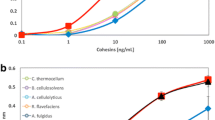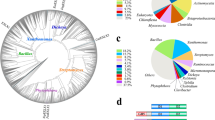Abstract
Molecular function of the expansin superfamily has been highlighted for cellulosic biomass conversion. In this report, we identified a new bacterial expansin subfamily by analysis of related bacterial sequences and biochemically examined a member of this new subfamily from Hahella chejuensis (HcEXLX2). Among the various complex polysaccharides tested, HcEXLX2 bound most efficiently to cellulose. The relative binding constant (K r ) against Avicel was 2.1 L g−1 at pH 6.0 and 4°C. HcEXLX2 enhanced the activity of cellulase, producing about 4.6 times more hydrolysis product after a 36 h reaction relative to when only cellulase was used. The extension strength test on filter paper indicated that HcEXLX2 has a texture loosening effect on filter paper, which was 53% of that observed for 8 M urea treatment. These activities, compared with a cellulose binding domain from Clostridium thermocellum, implied that the synergistic effect of HcEXLX2 comes from not only binding to cellulose but also disrupting the hydrogen bonds in cellulose. Based on these results, we suggest that the new bacterial expansin subfamily functions by binding to cell wall polysaccharides and increasing the accessibility of cell wall degrading enzymes.
Similar content being viewed by others
References
Adney, B., and Baker, J. (1996). Chemical Analysis and Testing Task: LAP-006 (Measurement of cellulase activities) (Golden, USA: National Renewable Energy Laboratory).
Carrard, G., Koivula, A., Söderlund, H., and Béguin, P. (2000). Cellulose-binding domains promote hydrolysis of different sites on crystalline cellulose. Proc. Natl. Acad. Sci. USA 97, 10342–10347.
Cosgrove, D.J., Li, L.C., Cho, H.-T., Hoffmann-Benning, S., Moore, R.C., and Blecker, D. (2002). The growing world of expansins. Plant Cell Physiol. 43, 1436–1444.
Din, N., Gilkes, N.R., Tekant, B., Miller, R.C., Warren, A.J., and Kilburn, D.G. (1991). Non-hydrolytic disruption of cellulose fibers by the binding domain of a bacterial cellulase. Bio/Technology 9, 1096–1099.
Gilkes, N.R., Jervis, E., Henrissat, B., Tekant, B., Miller, R.C., Warren, R.A.J., and Kilburn, D.G. (1992). The adsorption of a bacterial cellulase and its two isolated domains to crystalline cellulose. J. Biol. Chem. 267, 6743–6749.
Grundy, W.N., Bailey, T.L., Elkan, C.P., and Baker, M.E. (1997). Meta-MEME: Motif-based hidden Markov models of protein families. Comput. Appl. Biosci. 13, 397–406.
Henrissat, B., Driguez, H., Viet, C., and Schülein, M. (1985). Synergism of cellulases from Trichoderma reesei in the degradation of cellulose. Bio/Technology 3, 722–726.
Jeong, H., Yim, J.H., Lee, C., Choi, S.-H., Park, Y.K., Yoon, S.H., Hur, C.-G., Kang, H.-Y., Kim, D., Lee, H.H., et al. (2005). Genomic blueprint of Hahella chejuensis, a marine microbe producing an algicidal agent. Nucleic Acids Res. 33, 7066–7073.
Kende, H., Bradford, K.J., Brummell, D.A., Cho, H.T., Cosgrove, D.J., Fleming, A.J., Gehring, C., Lee, Y., McQueen-Mason, S., Rose, J.K.C., et al. (2004). Nomenclature for members of the expansin superfamily of genes and proteins. Plant Mol. Biol. 55, 311–314.
Kerff, F., Amoroso, A., Herman, R., Sauvage, E., Petrella, S., Filé, P., Charlier, P., Joris, B., Tabuchi, A., Nikolaidis, N., et al. (2008). Crystal structure and activity of Bacillus subtilis YoaJ (EXLX1), a bacterial expansin that promotes root colonization. Proc. Natl. Acad. Sci. USA 105, 16876–16881.
Kim, E.S., Lee, H.J., Bang, W.-G., Choi, I.-G., and Kim, K.H. (2008). A novel cellulase activity enhancing protein from bacillus subtilis, a functional homolog of a plant expansin. J. Biotechnol. 136S, S426.
Kim, E.S., Lee, H.J., Bang, W.-G., Choi, I.-G., and Kim, K.H. (2009). Functional characterization of a bacterial expansin from bacillus subtilis for enhanced enzymatic hydrolysis of cellulose. Biotechnol. Bioeng. 102, 1342–1353.
Kwon, Y.R., Lee, H.J., Kim, K.H., Hong, S.-W., and Lee, H. (2008). Ectopic expression of Expansin3 or Expansin beta 1 causes enhanced hormone and salt stress sensitivity in Arabidopsis. Biotechnol. Lett. 30, 1281–1288.
Lee, J., and Kim, S.H. (2009). High-throughput T7 LIC vector for introducing C-terminal poly-histidine tags with variable lengths without extra sequences. Protein Expr. Purif. 63, 58–61.
Lynd, L.R., Laser, M.S., Bransby, D., Dale, B.E., Davison, B., Hamilton, R., Himmel, M., Keller, M., McMillan, J.D., Sheehan, J., et al. (2008). How biotech can transform biofuels. Nat. Biotechnol. 26, 169–172.
McQueen-Mason, S., and Cosgrove, D.J. (1994). Disruption of hydrogenbonding between plant cell wall polymers by proteins that induce wall extension. Proc. Natl. Acad. Sci. USA 91, 6574–6578.
McQueen-Mason, S.J., and Cosgrove, D.J. (1995). Expansin mode of action on cell walls (analysis of wall hydrolysis, stress relaxation, and binding). Plant Physiol. 107, 87–100.
Merino, S.T., and Cherry, J. (2007). Progress and challenges in enzyme development for Biomass utilization. Adv. Biochem. Eng. Biotechnol. 108, 95–120.
Morag, E., Lapidot, A., Govorko, D., Lamed, R., Wilchek, M., Bayer, E.A., and Shoham, Y. (1995). Expression, purification, and characterization of the cellulose-binding domain of the scaffoldin subunit from the cellulosome of Clostridium thermocellum. Appl. Environ. Microbiol. 61, 1980–1986.
Notredame, C., Higgins, D.G., and Heringa, J. (2000). T-coffee: a novel method for fast and accurate multiple sequence alignment. J. Mol. Biol. 302, 205–217.
Qin, L., Kudla, U., Roze, E.H.A., Goverse, A., Popeijus, H., Nieuwland, J., Overmars, H., Jones, J.T., Schots, A., Smant, G., et al. (2004). Plant degradation: a nematode expansin acting on plants. Nature 427, 30–30.
Retief, J.D. (2000). Phylogenetic analysis using PHYLIP. Methods Mol. Biol. 132, 243–258.
Saloheimo, M., Paloheimo, M., Hakola, S., Pere, J., Swanson, B., Nyyssönen, E., Bhatia, A., Ward, M., and Penttilä, M. (2002). Swollenin, a Trichoderma reesei protein with sequence similarity to the plant expansins, exhibits disruption activity on cellulosic materials. Eur. J. Biochem. 269, 4202–4211.
Sampedro, J., and Cosgrove, D.J. (2005). The expansin superfamily. Genome Biol. 6, 242.
Shin, J.-H., Jeong, D.-H., Park, M.C., and An, G. (2005). Characterization and transcriptional expression of the α-expansin gene family in rice. Mol. Cells 20, 210–218.
Tomme, P., Creagh, A.L., Kilburn, D.G., and Haynes, C.A. (1996). Interaction of polysaccharides with the N-Terminal cellulosebinding domain of cellulomonas fimi CenC. 1. binding specificity and calorimetric analysis. Biochemistry 35, 13885–13894.
Tormo, J., Lamed, R., Chirino, A.J., Morag, E., Bayer, E.A., Shoham, Y., and Steitz, T.A. (1996). Crystal structure of a bacterial family-III cellulose-binding domain: a general mechanism for attachment to cellulose. EMBO J. 15, 5739–5751.
Wilson, D., Pethica, R., Zhou, Y., Talbot, C., Vogel, C., Madera, M., Chothia, C., and Gough, J. (2009). SUPERFAMILY-sophisticated comparative genomics, data mining, visualization and phylogeny. Nucleic Acids Res. 37, D380–D386.
Xiao, Z., Storms, R., and Tsang, A. (2004). Microplate-based filter paper assay to measure total cellulase activity. Biotechnol. Bioeng. 88, 832–837.
Yennawar, N.H., Li, L.-C., Dudzinski, D.M., Tabuchi, A., and Cosgrove, D.J. (2006). Crystal structure and activities of EXPB1 (Zea m 1), alpha,beta-expansin and group-1 pollen allergen from maize. Proc. Natl. Acad. Sci. USA 103, 14664–14671.
Author information
Authors and Affiliations
Corresponding author
About this article
Cite this article
Lee, H.J., Lee, S., Ko, Hj. et al. An expansin-like protein from Hahella chejuensis binds cellulose and enhances cellulase activity. Mol Cells 29, 379–385 (2010). https://doi.org/10.1007/s10059-010-0033-z
Received:
Revised:
Accepted:
Published:
Issue Date:
DOI: https://doi.org/10.1007/s10059-010-0033-z




